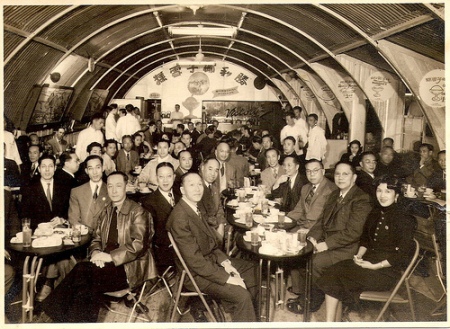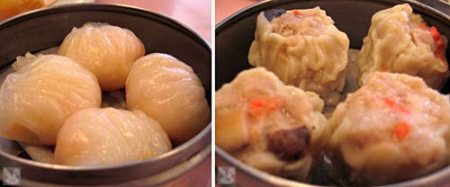As a British Born Chinese, I have lived a very British way of life being educated in Manchester and Australia. However, throughout my life, I grew up with the backdrop of serving and cooking in the family restaurant and continue my involvement in the catering empire as a co-owner of Sweet Mandarin Restaurant (www.sweetmandarin.com).

(Illustration by Lisa Tse “To The Ruler, the People are Heaven, to the People Food is Heaven”)
Chinese food has had an overwhelming presence in my life and been the catalyst for my hunger for understanding China and the significance of food in its culture. This series explores the cities where I stayed, the lives that crossed my path and the amazing food with a story to tell. China is a captivating and vivacious collection of diverse cities, provinces and regions. In the south, Guangdong, the Cantonese speaking region is renowned for its steaming, boiling and stir frying and dim sum feasts which we have become accustomed to and love in the western world. Beijing in the coldest area of China boasts the Emperor’s banquet, the world famous Peking Duck and hot pot. In the east, Shanghai offers its famous Shanghai Dumplings, whilst the Sichuan provinces easily provide the hottest and spiciest cuisine.
I finally arrived at Guangzhou which is famous for its “dim sum”. Literally translated, “dim sum” means “to touch your heart”. Guangzhou is north of the Pearl River Delta, adjacent to Hong Kong and holds a special place in my heart as the place where my family originates from. The nickname for this province is “Flower City” because flowers keep blossoming all year round.

(Five Ram Statute in Guangzhou)
It also holds the myth that there were five celestials riding five rams with rice in their mouth. The celestials gave the rice to the residents of Guangzhou and blessed the province with good harvests and an abundance of food. Today, the celestials have flown away but the five rams have been turned into stone sculptures in the Yuexiu Park area. The blessings have seemingly been fulfilled and the city is brimming with masses of people, bicycles and restaurants.
To date, there are over 10,000 restaurants in the city, with seats for over 500,000. The people of Guangzhou are natural born gourmets. Food in Guangzhou is famous worldwide. Indeed in 1927, Chiang Kai-Shek, the leader of the nationalist party responsible for unifying China, set up his headquarters in Guangzhou and enjoyed dining at the many restaurants serving dim sum.

(Dim Sum Mania on Sunday Mornings)
Dim sum is often referred to as “yum cha” (饮茶) which means “drinking tea”. This interchangeable expression originated from the teahouses which set up along the Silk Road. The Silk Road linked China to Syria and was travelled by merchants and farmers trading their silk, gold, ivory, spices, exotic animals and plants. Travellers and rural farmers, exhausted after working hard, would also go to teahouses for a relaxing afternoon of tea. At first, it was considered inappropriate to combine tea with food, because people believed it would lead to excessive weight gain. However, people later discovered that tea can aid in digestion. Therefore, teahouse owners began adding more variety of snacks, so the tradition of dim sum evolved.

(Dim Sum Restaurant – Old Hong Kong)
Dim sum mania spread to Hong Kong as the Guangzhou population immigrated to Hong Kong in the 1920s. Chinese restaurants grew exponentially in Hong Kong and soon dim sum was available from 6am through to late afternoon. Restaurants in Hong Kong and Guangzhou became filled mainly with the elderly population who often gathered to eat after the morning session of tai chi exercises, often enjoying the morning newspapers.
In the west, dim sum came about as a natural result of Chinese immigrants moving to the western world. When Europe started trading with the Orient, the seaport of Guangzhou became the gateway to the West. The Chinese readily absorbed these cosmopolitan influences, and being great travellers themselves, emigrated to the United States of America and the United Kingdom. They were the first to make Chinese cooking known to the Western world and as a result dim sum has become the firm favourite of the Western world.

(A Packed Dim Sum Session)
Go to a Chinese restaurant on a Sunday afternoon and you will be greeted by a sea of Chinese families spanning three generations. Dim sum is the Chinese equivalent of French hors d’oeuvres or Spanish tapas. It’s a colourful and loud dining experience starting with the rush for vacant seats and the hustle and bustle of the gesticulating waiters selling their dim sum specials from their trolleys. Bamboo containers filled with steamed dim sum are stacked high and quickly snapped up. Waiting on staff ask what kind of tea we want to drink offering a vast array of jasmine tea, oolong tea, pu-er tea and green tea which helps to wash down the dim sum. The noise of the chatter of the diners is deafening. It’s a busy, frantic affair and there is an air of organized panic in the restaurants, which adds to the excitement and entertainment. Dim sum is an overwhelming introduction to the Chinese nation’s love of food, gregariousness and cheerful chatter.
I love dim sum. There are over 200 dishes to choose from. One Cantonese saying goes that anything that walks, swims, crawls, or flies is edible. Another says that the only four-legged things that Cantonese people won’t eat are tables and chairs.
The range of cooking skills required to make dim sum is vast. There is usually a dim sum master overseeing his section of the kitchen and there is a real art involved in making the dishes. Some dishes are steamed, others are fried. Some are baked. The variety of tastes is also mind boggling – sweet, sour, savoury and chilli.

(Left: Har Gow, Right: Siu Mi)
There are firm favourites such as “har gow” (prawn dumplings wrapped in translucent rice paper), “siu mi” (pork dumplings) and “char siu bow” (pork buns in a white fluffy dough). If you are feeling more adventurous, an eye opening experience with a stronger flavour is “fung jow” (chickens feet in yellow bean sauce and chillis). One caveat – this particular dish is not for the faint hearted. The sweet dishes for dessert range from the egg custard tarts which are extremely delicious to sago pudding or mango pudding which are refreshing and a great ending to the dim sum experience.

(Me (Left) learning how to make dim sum with my sister (centre) and mother, Mabel (Right))
A meal in a restaurant opens the taste buds, but cooking dim sum for my friends and family widens all the senses. I learnt the authentic recipes from Guangzhou and used them at Sweet Mandarin. Together with my sisters, Helen and Janet we made every dim sum from fresh. Stuffing and shaping wontons was the real family enterprise. We made the stuffing from a light prawn mince and wrapped the teaspoon of filling with a fine egg based pastry. We all left our individual stamp on the won tons in the way we crimped the edges. I added a flamboyant tail on these wontons, which can then be dipped in the sweet and sour dip. My everyday rituals of properly selecting produce, cooking and presenting a meal, which I have inherited from my family, have given me an insight to see the meaning of my own cooking as a metaphor for life.
I would love to share with you our recipe on making this exquisite dim sum.

Ingredients
For the Prawn Filling
250g pack shrimps
2 tsp soy sauce
1 tsp sesame oil
1 tsp potato starch
1 egg white
1 tsp salt
1 tsp sugar
Hot vegetable oil to lightly fry the wontons
Ingredients for the Wonton Wrappers
1 tsp sugar
1 tsp salt
1 egg yolk
1 tsp potato starch
1/4 cup of water
2 cups of plain flour
Dressing for the wontons
Serve with Sweet Mandarin’s The General Tse’s Sweet and Sour Sauce
Method to make the wonton pastry
1. Kneed the ingredients together into a ball. The consistency is dough like.
2. Leave in the fridge for half an hour.
3. Roll out into a very thin sheet (as thick as a piece of paper) with a rolling pin ensuring there is plenty of flour to avoid sticking.
4. Cut into squares 3inches squared.
Method to make delicious and easy wontons
1. Put all the prawn mixture into a food processor and mix thoroughly.
2. Shape into balls the size of walnuts.
3. Place the filling balls into the centre of the wonton wrappers. To make the tail, gather the four edges and twist together.
4. Heat oil
5. Place wontons in hot oil for 5-6 minutes or until cooked through.
6. Drain from oil.
7. Serve the wontons with the Sweet Mandarin’s General Tse’s Sweet and Sour Sauce.
Sweet Mandarin offers a brunch special on Saturdays and Sundays – Eat all you can Dim Sum for 10 pounds per head. Match with Jasmine Tea and it makes for a wonderful relaxing weekend with friends and family. For more information, go to www.sweetmandarin.com To book a table email sweetmandarin@gmail.com

 Balancing Yin and Yang can improve one’s hair and skin.
Balancing Yin and Yang can improve one’s hair and skin.